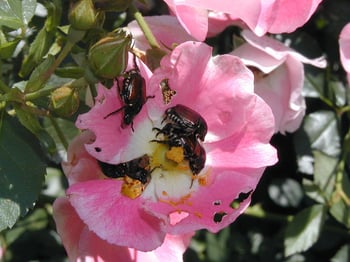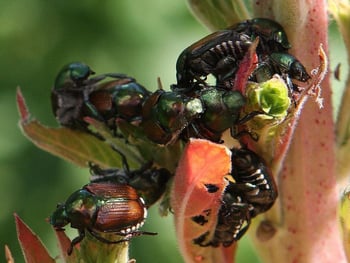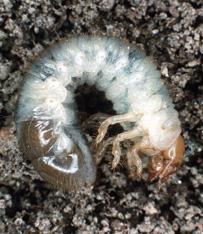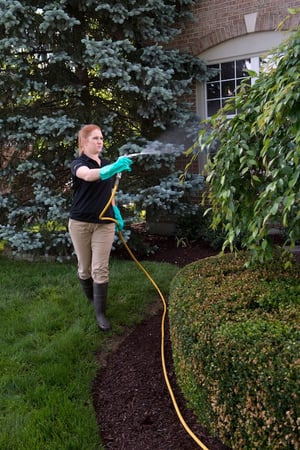Imagine walking out of your house one day to find that your carefully-tended prize rose bush has been destroyed. Or maybe you notice that every time you pass your favorite birch tree, its leaves look more and more chewed-up. If so, you probably have also spotted the shiny, metallic hard-shelled culprit among the crisp green leaves: the Japanese Beetle.
The Old Farmer’s Almanac names Japanese Beetles as one of the most troublesome pests of the eastern and midwestern parts of the country. While they are relatively small in size, they can be incredibly destructive. In fact, Japanese Beetles are known to cause damage to some 300 species of plants, including common ones like roses, birch trees, linden trees and purple-leaf plum trees.
Looking at defoliated and damaged plants for the rest of the summer and fall can put quite a damper on your enjoyment of the landscape. Furthermore, although the effect of the beetles may at first be only a cosmetic concern, repeated trouble year after year can cause more serious problems. We know that dealing with Japanese Beetles can be frustrating. There is a lot of misinformation out there about Japanese Beetle control, but we’ll give you all the essentials you need to know to cope with them.
Here are 8 Japanese Beetle facts that will help you to better understand these destructive pests and how to deal with them on your property in Cincinnati, Dayton, OH, or Northern Kentucky.
1. They Are Not Native to the US
Perhaps this is not a big surprise to you based on the name, but Japanese Beetles were unknown in the United States until 1916 when they were accidentally introduced into New Jersey. Up until that point, they were known to exist only in Japan, where they were not considered a major pest. Unfortunately, here in the United States, they do pose a major problem--not only to personal landscapes but also to our crops.
2. Japanese Beetles Prefer Sun
 You’re more likely to see a lot of Japanese Beetles on sunny days. Their preference for the sun is another reason they’re easy to see, as you’ll typically find them on top of your plants then, basking in the bright sunshine as they enjoy their meal…your landscape.
You’re more likely to see a lot of Japanese Beetles on sunny days. Their preference for the sun is another reason they’re easy to see, as you’ll typically find them on top of your plants then, basking in the bright sunshine as they enjoy their meal…your landscape.
3. Japanese Beetles are Easy to Spot
Unlike many other pests, Japanese Beetles are easy to spot. Adult Japanese Beetles are approximately a half-inch in length, with metallic-green shells and copper-colored wings. Their damage is also quite noticeable, because their sharp, chewing mouthparts will skeletonize leaf tissue and leave behind only the vascular section.
4. There are Some Plants They Avoid
While Japanese Beetles are known to eat more than 300 species of plants, they do prefer certain ones more than others. We have already mentioned a few plants they love. Some they do not seem to like include boxwood, burning bush, magnolia and redbud. Although it’s not a foolproof method, planting species that are not favorites of the pest is one natural form of Japanese Beetle Control you can employ.
5. They Feed in Groups
 Japanese Beetles are typically found in large groups. A single beetle isn’t going to do much damage on its own, but while that one beetle feeds, it releases what is known as a “congregation pheromone” to attract others of its kind.
Japanese Beetles are typically found in large groups. A single beetle isn’t going to do much damage on its own, but while that one beetle feeds, it releases what is known as a “congregation pheromone” to attract others of its kind.
Then it will seem as if the individual Japanese Beetle has invited all of his friends to dine on your tree with him. These group feedings are when you will really start to notice the damage.
6. Adult Japanese Beetles Don’t Live Long
We’ll talk a bit more about the Japanese Beetle life cycle next, but be aware that these pests do not live long, an average of only 30 to 45 days for each beetle. A short lifespan may sound promising for dealing with this invasive species, but remember that when you have an infestation by a large population, there is always another one to take an individual’s place. That’s why Japanese Beetle control is important.
7. The Japanese Beetle Life Cycle Means Trouble
 One of the most troubling Japanese Beetle facts is that they are pests to your property for their entire lifespan. Few pests are quite as big a burden. The Japanese Beetle life cycle is relatively simple. They begin their lives as Japanese Beetle grubs, chewing on grass roots with an intensity that can destroy your lawn.
One of the most troubling Japanese Beetle facts is that they are pests to your property for their entire lifespan. Few pests are quite as big a burden. The Japanese Beetle life cycle is relatively simple. They begin their lives as Japanese Beetle grubs, chewing on grass roots with an intensity that can destroy your lawn.
The mature adult Japanese Beetles feed and mate in June and July, during which time the female lays her eggs (from one to five of them during each of the multiple egg-laying periods) in the soil. By late September, these hatched Japanese Beetle grubs (larvae) are almost full grown and busily feeding on your lawn’s grass roots.
8. Japanese Beetle Traps Only Attract More Beetles
One of the biggest misconceptions about Japanese Beetle control is the idea that Japanese Beetle traps are the best way to deal with them. These traps work by releasing a pheromone that attracts adult beetles. What looks like a highly-effective solution as you watch the bag fill up is, in reality, simply a sign that the trap is attracting beetles to your home from neighboring yards in the area. Ultimately, you are merely drawing more Japanese Beetles onto your property than you had before.
Japanese Beetle Control
 Now that you know that Japanese Beetle traps are not the best way to deal with these pests, what can you do? Japanese Beetles are admittedly difficult to deal with and yet they also happen to be a pest most homeowners will wind up facing. Chances are you’ve already had a problem in the past. So it is definitely a good plan to sign up for a tree and shrub care program that will cover the Japanese Beetle problem as part of an overall, comprehensive program promoting quality health for your entire landscape.
Now that you know that Japanese Beetle traps are not the best way to deal with these pests, what can you do? Japanese Beetles are admittedly difficult to deal with and yet they also happen to be a pest most homeowners will wind up facing. Chances are you’ve already had a problem in the past. So it is definitely a good plan to sign up for a tree and shrub care program that will cover the Japanese Beetle problem as part of an overall, comprehensive program promoting quality health for your entire landscape.
At Oasis Turf & Tree we do not perform one-time visits for Japanese Beetle control. There are other, ongoing issues which can occur throughout the season on various plants in your landscape and a one-time visit simply does not provide you with a good value for your investment. Japanese Beetles are just one of the many issues we cover under the scope of our complete tree and shrub health care program.
While you may see one big problem on your landscape (such as the very-noticeable Japanese Beetle damage), there are probably some other problems going on that we should address. In fact, 9 times out of 10 when one of our techs shows up to treat for Japanese Beetles, we find other concerns that really need to be tackled as well.
If you have plants in your landscape that are being consumed by Japanese Beetles, the plants’ resources will be depleted and they’re not going to thrive. That’s why buying a Japanese Beetle control product and spraying it on your plants may not be enough to fix the problem. You also need to restore health to the plant by supplying good nutrition. This is why having an all-inclusive program is so beneficial.
If you’re dealing with a Japanese Beetle problem, a trained technician working on your property can help. At Oasis Turf & Tree, we’d love to assist you in restoring good health to your beloved landscape, while preventing it from becoming a meal for the pesky Japanese Beetle.
If you want to find out more about how our tree and shrub program can help tackle Japanese Beetles and other common pests, contact us for a free consultation or give us a call at 513-697-9090 so that we can answer any questions.
Image Sources: Japanese Beetle on leaf, Japanese Beetles, Japanese Beetles on Roses, Japanese Beetle Grubs
